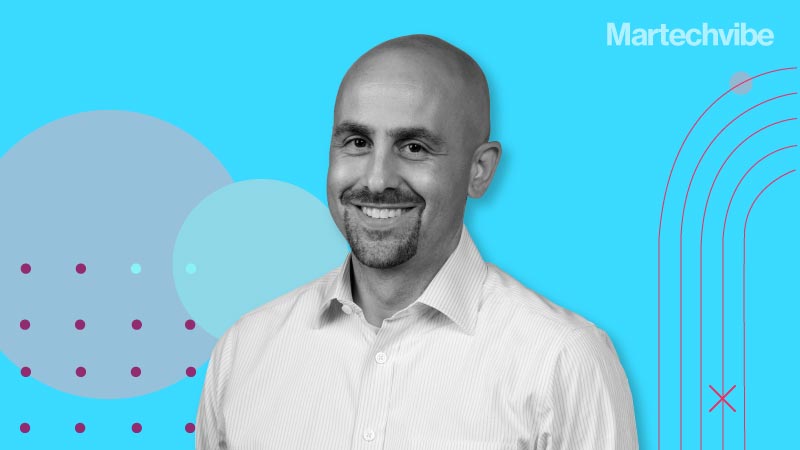Look for the Root Cause Behind Customer Complaints
International customer experience keynote speaker Dan Gingiss has a bone to pick with anyone who refers to customer experience as a soft skill. It is no longer a nice-to-have – it’s a must-have. “It is as important as your finance team, legal team, or anything that is a hard skill. And the reason is that […]
Topics

International customer experience keynote speaker Dan Gingiss has a bone to pick with anyone who refers to customer experience as a soft skill. It is no longer a nice-to-have – it’s a must-have. “It is as important as your finance team, legal team, or anything that is a hard skill. And the reason is that it directly connects to a company’s profitability,” he says.
Martechvibe spoke with Gingiss, Chief Experience Officer at The Experience Maker, about the challenges all marketers face in implementing CX strategies. He spoke about how to create remarkable experiences that become their best sales and marketing strategy. His unique combination of a credible professional background, presentation skills, and entertaining, motivational examples make him one of the best CX speakers.
Excerpts from the interview;
Tell us about your journey.
I have spent 20 years as a marketer in big companies, credit card companies, healthcare companies, and McDonald’s. Over time, I learned how to use all sorts of marketing channels and how to attract new customers. But I also started to learn about customer experience and how to talk to customers who were already part of the business and were already spending money with us.
I found that focusing on existing customers was a better strategy than constantly looking to acquire new ones. We all know that it’s a lot cheaper to keep an existing customer than it is to get a new one. But we have got to spend time on them. We have got to focus on their needs and on delivering and exceeding their expectations.
Eventually, in my career, I moved away from marketing and towards customer experience. But when I went off on my own and started my own company in 2019, I wanted to sit at the intersection of customer experience and marketing because when you create great experiences, your customers do the marketing for you.
They talk about you and tell other people how great it is to do business with you, and that’s the best marketing there is.
Online commerce was booming in 2020, and so did user-generated content. How can it be leveraged to share authentic stories and drive loyalty?
When customers talk about us positively, it is far more credible than when we talk about ourselves. It’s always better for a customer to say, “Hey, Dan’s a really great speaker, or, I love Dan’s book,” than for me to tell you because it doesn’t sound the same. Customer stories are a great way to show this, but for them to be authentic, we can’t ask for them. We have got to have customers that want to talk about us, and to do that, we intentionally create experiences that people want to share.
While researching, I found that people are more willing to share positive experiences than negative ones. But most people, when you ask them, can’t remember the last time they had a really good experience with any company. And that’s the opportunity – if we can create that positive experience and get people talking about us, then it’s incredibly genuine and authentic and can take the place of a lot of the sales and marketing we are doing.
All you have to do is look at Instagram to see that people want to share things that are going well. They want to share the beautiful new clothing they bought, or the great restaurant – the amazing-looking food or whatever it is. People want to share positive things, but they struggle to find them, at least with the companies they do business with.
Another thing I liked about your question is you mentioned customer stories, and I am a big believer that storytelling is how people like to learn. In fact, that is how I teach when I speak or coach, I tell stories because everybody likes to be told a story. Everybody likes to hear a story. It’s much more memorable because people can relate to the story somebody told them. We all remember stories from our childhood that our parents read to us. Similarly, even in business, it’s far more memorable when you tell a good story.
What common mistakes must always be considered and avoided when working on a CXM strategy?
There are two. The first is not listening to your customers. When you ask customers for feedback, you’re going to get it. The question is – are you ready to hear it? Feedback is going to come in a lot of forms. It is going to come as compliments and tell you everything you are doing well that people like about your business. That’s really important because if people like it, we should do more of it.
They will also tell you what they don’t like about your business. They are going to give you some complaints. They will ask you to fix some things, and if we can take that in and do something about it, we will make great strides towards improving the customer experience. But often, companies don’t want to hear the complaints, or they think that just one customer is upset about something. They don’t look for the root cause of why somebody might be complaining, calling customer service, or even leaving the business. Complaints can also be incredibly valuable. Not listening to customers is the number one mistake.
Number two is being unable to view your business through the customer lens. What I mean by that is that when we sit in our offices, we look outwards at customers. We do not see the view they’re seeing because they’re looking inwards at us, our company.
Think about a doctor’s office or a dentist’s office. I did some research and in the United States, most dentists have their office at the back and they have a separate entrance into the building. They do this because they don’t want to walk through a waiting room with people because they are afraid that those patients will be upset. But when they walk in the back door every day, they don’t ever see who their patients are. I always recommend to doctors and dentists that, at least once a week, walk in through the front door because when you do that, you are going to see that nobody’s cleaned the front door in a long time. There’s a lot of fingerprints, or there’s a lot of dust. You will see that the magazines in the waiting room were last updated two years ago. You will see that the coffee station is out of coffee or needs to be cleaned. If you are always walking in the back door, you never see that.
Now, if you’re in an ecommerce company with no front or back door, the same thing holds true. The way that we deal with it is – we go shopping at our own ecommerce company, we put stuff into a cart, we check out, we pay with our credit card, we try to return something, and we go through all of the motions that we make our customers go through. When you do that, you have much better insight into the experience.
We are all consumers, too, right? We all shop online. We go out to restaurants. So we all know what it’s like to be a consumer, but often we need to know what it’s like to be a consumer of our business.
A good deal of personalisation requires brands to know their customer’s choices and routines in detail. How can brands ensure their process respects the customer’s privacy?
There is a delicate balance between convenience and privacy or personalisation and privacy. What’s interesting is that younger generations, millennials and Gen Z, are more than willing to give up privacy to get personalisation.
They want the personalisation, and so that’s certainly helpful – we have got to be aware of that. We also must be aware that older generations may not be willing to make the same trade-off. One of the ways that we can do both is by looking for trends, looking for what happens when multiple customers get to a certain point.
If we know that a customer is looking to buy a home, we also know that they may eventually need a mortgage. That’s an obvious next step. If we can be proactive and say, “Hey, we notice that you are looking for a home, may we also set you up with a company that can provide you with a mortgage?” Now you have not lost any privacy, but you have got ahead of the experience and created something personalised.
The other way, I think, is to ask customers – I call this self-personalisation. A great example here is that my legal name is Daniel. But nobody calls me Daniel other than my mother when she’s mad at me. So, I don’t want anybody to call me Daniel. That’s why I go by Dan. If I log into my bank, it says, “Good morning, Daniel.” They think that they’re being personalised. But I feel they are annoying. So we missed something here.
Well, one of my banks recently said, What would you like to be called? And this was a great question. So I wrote in Dan, and guess what? Now when I log into the website, it says, “Good morning, Dan”. That’s what I call self-personalisation because I understand why they had Daniel in their system. It is my legal name, it’s how I had to sign up for the bank account. But that doesn’t necessarily mean that they are providing any personalisation and, in fact, might be providing the opposite.
When you ask customers things, they tell you and they personalise their own experience. Other examples of this would be – take a look at anybody’s phone and you will see that there are no two Home Screens on planet Earth that look the same because we all get to personalise our Home Screens. We get to choose which apps we want. We get to choose the colour of the background or the photo that’s on the wallpaper. We get to choose where we want the clock to be if we want the weather report and all that sort of thing. That’s all self-personalisation, and that is something to look at no matter what kind of business you are in. By definition, the customer is okay with that balance between privacy and personalisation because it is their choice to personalise.
Marketers think they’re personalising because they have used your name in an email or a letter, which is the most basic form of personalisation. Many companies get it wrong because we have all got emails saying, “Dear <First Name>. So that kind of personalisation, if that’s all you’re doing and trying to be personalised, then you are missing something. It is about getting to know your customers as human beings and getting to know their preferences and interests.
During the last few years, with the pandemic, we have had so many more virtual interactions that have given us a better chance to get to know people because we see a cat walking around in the background, or we see a baby, or we see something that’s on somebody’s wall. Now we know something about them. And it’s not about being creepy, it’s about knowing that if somebody has a cat, the best way into somebody’s heart is through their kids or pets, right? If we could do something somewhere in the experience for our customers’ cats, it would be something they don’t expect, and they’re going to love us for it. It’s about trying to get to know your customers so you can personalise them in a way that makes sense.
Let me give you one more example because it’s still banking. So my father, who is 80, has never used an ATM card. He always walks into the bank, and part of it is because he likes to walk into the bank. The tellers greet him and say, “Good morning, Mr Gingiss”, and they know who he is and that’s what he likes.
My generation, I am Gen-X, I rarely go into the bank, but I use my ATM card all the time. My kids, who are Gen-Z, don’t even know what to do with cash. They don’t have cash ever. They’re only using digital transactions like Zellar or some other platform like Venmo, where they send money back and forth between their friends and pay with their phones. Three generations, three different experiences using the same bank – people want different things.
How can we get employees to share customer-facing feedback through the organisation?
It is a place where many companies miss out when they get customer feedback – our first instinct is to solve a problem for that customer. That’s a good instinct. If somebody calls us and they have a problem, we should first fix it there. But we have to make sure that we look back at the root cause of their problem and say – why didn’t this person call in the first place?
When I worked at a credit card company, we had some estimates that suggested that for every person that called, there were a hundred people that had the same problem and didn’t call. Those hundred people are dangerous because what’s happened is they are upset, but they are not sharing the concern. Those are the people that are most likely to leave your business eventually if you still need to provide the experience. So we would always ask ourselves why this person called after we solved their problem.
We asked, what in our experience caused them to call? Oh well, the mobile app was not functioning. We have got to send this feedback now to tell the mobile app team, and hold them accountable to investigating it and fixing it so that we don’t get any more phone calls about this particular problem.
When I worked at the credit card company, I ran the website in the digital customer experience area. I worked very closely with the customer service team, and we would have a call type – let’s say people were calling because they were having trouble redeeming their credit card rewards. My team would go in, and we would fix that experience. We would create a chart that would show the number of phone calls that people had coming in and the call type was “rewards problem” and then we would fix the issue on the website, and we would watch as that chart completely dropped. From hundred calls to now, it’s just two calls because we fixed the problem. If we didn’t have a relationship between the digital and customer service teams, that problem would never get fixed.
That’s what most companies miss – they must communicate customer issues to the rest of the organisation. My suggestion is that the customer service team should have regular interactions and regular meetings with the key departments within the company where they review – here’s why people are calling, here are the complaints that we are seeing, here are the issues that are coming up, and they agree together on how they are going to get them fixed.
At the heart of The Experience Maker book is your WISE(R) Model. How did you come up with your WISE model?
It is actually the acronym – WISE. In the end, I surprised people by adding an R at the end to say WISER.
As I like to say, I want to make you wise to customer experience and then I want to make you wiser than the competition. So WISER is the acronym I came up with to teach people how to create the kinds of experiences people want to talk about. We want to create an experience so that our customers tell stories about how great it is to do business with us.
The WISE acronym stands for Witty, Immersive, Shareable and Extraordinary. And each of those four things is an element of creating experiences people want to discuss. Once we do that, and we have got people talking about us, the R is about being Responsive and making sure that you are in all the channels that your customers are in, that you are active on social media and if people are talking about your brand on social media – you are engaging in conversation because today’s consumer wants a relationship with the companies that they do business with and that’s what WISER is. Each one of the letters has a lot of different examples in terms of how to execute them at your business. Since I spent so much time in corporate America, I know how difficult it is to get things done. All the examples I share are simple, practical and inexpensive.
I never sit there and tell a story about how a hotel spent $5 Million to create this great experience because most companies don’t have a budget like that for customer experience. We have to focus on the things we can do quickly, simply and inexpensively.
What are your predictions for trends in customer experience in the coming year?
A couple of trends are emerging from the pandemic, the first is around safety. We all went through a period where we didn’t feel as safe as we once did. We were worried about being in large groups. We were concerned about which location we had a bigger chance of catching this virus. So, safety in all forms is a key component of the experience. It is about more than whether we will catch the Covid-19 virus somewhere. It is physical, emotional, and digital safety – whether our data is safe or not. All these things go into how we choose the types of companies that we do business with.
Customers today want a relationship with companies. We spend our hard-earned money with companies, whether a clothing store, restaurant, or whatever it is, and we want to feel that loyalty goes both ways – that we are loyal to a brand, and the brand is loyal right back to us. That they appreciate us, they know us. That will continue to be a real trend in customer experience. The brands that know me are the ones that I love and want to go back to again and again.
What is your favourite CX metric?
My favourite CX metric is customer retention rate – the opposite of customer churn rate. I like to look at the percentage of customers we were able to keep. I try to be positive about everything. If you want to look at the churn rate – which is how many customers you lose, that’s fine as well.
The reason I like this metric is that it directly connects to the bottom line of the business. There are so many executives that still think that customer experience is a soft skill – that it is nice to have and not to must-have. It is just as important as your finance team, legal team, or anything that is a hard skill. The reason is that it directly connects to a company’s profitability. When we look at the percentage of customers we keep and we know the value of each customer experience programme, I always focus on that one.
Other stats like customer satisfaction are great statistics, they tell you how you are doing. They don’t necessarily tell you why, and they don’t make a direct connection to the bottom line, whereas a retention rate does.








































































































